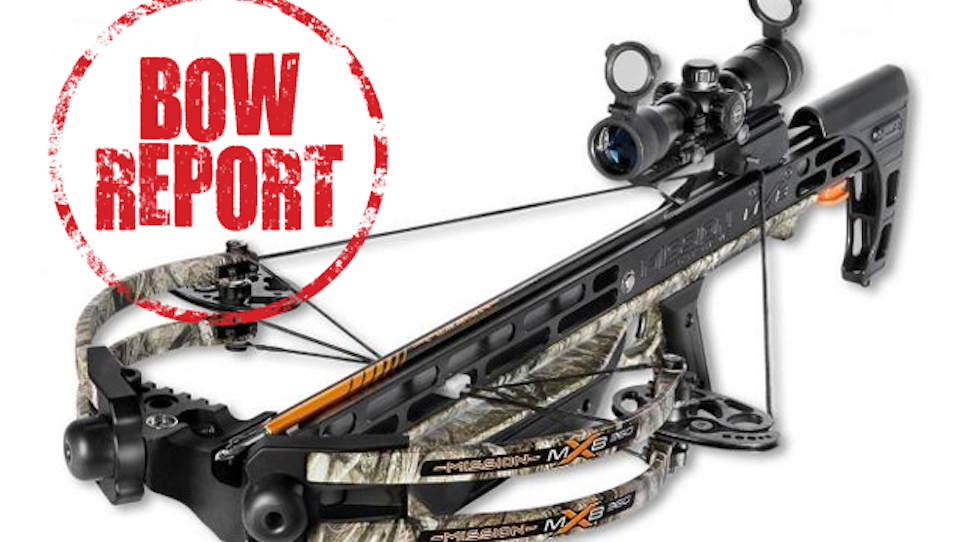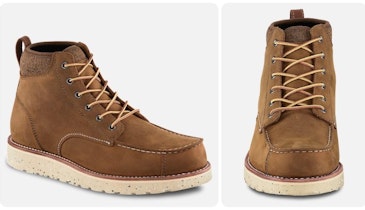One of two new offerings in Mission’s MXB series of crossbows is the Mission Dagger. Based on the MXB 320, the minimalist design, including the black squared stock, pistol grip and ventilated barrel, along with the short forearm and scope mount rail, fairly scream “Mission Crossbow.” (And if that doesn’t tip you off, the characteristic lack of a stirrup should make it obvious. More about that later.)
At 30 inches in length, it’s short by any standard—in fact, it’s Mission’s shortest crossbow to date. The 10-inch power stroke is even more remarkable, especially given the Dagger’s respectable speeds. It’s powered by the new WX-cam, a perimeter-weighted cam that hearkens back to the perimeter-weighted cams introduced by sister company Mathews on its vertical compound bows. The function is much the same: to increase efficiency by adding momentum while at the same time serving to reduce noise and recoil. That, together with the 220-pound split limbs, are behind the Dagger’s speed.
Adjustable draw weight is another Mission crossbow feature, and this is accomplished by simply turning limb bolts in the same manner as adjusting draw weight on most vertical bows. The Dagger has a peak draw weight of 220 pounds, adjustable all the way down to 125 pounds. (Even at the minimum 125 pounds, the Dagger produces more than adequate speeds up to 243 fps.) Mission dubs it the ALRS (Adjustable Limb Retention System), and it offers the added advantage of enabling shooters to relax the limbs for changing strings or cables without a bow press. It’s a very nice feature.
Earlier I referenced the lack of a stirrup. Instead, the MXB crossbows employ a tread that is inside the limbs, on either side of the barrel, which Mission refers to as the RS (Riser Step) Tread. Essentially, the foot is placed on the riser tread, instead of the more conventional stirrup, to cock the crossbow. Durable synthetic “bumpers” extend from the limb bolt insertion points on the outside of the limbs, and these are placed on the ground to protect the limbs when the crossbow is cocked. As Mission points out, this eliminates the considerable weight of the stirrup, and it also places the crossbow closer to the ground and farther away from the shooter’s shoulders as it’s cocked, which makes for an easier draw. It also tends to move the crossbow’s balance point farther back for better overall balance.
The MXB series crossbows come with a soft case, quiver, three bolts, and, depending on the package purchased, one of several Hawke scopes. The package tested included the Hawke XB Pro Scope, variable from 1.5-5x32 with two-color illumination and a speed adjustment dial. Several optional accessories are available, most notably Mission’s new RSD (Removable Silent Draw) system, essentially a mechanical cocking aid that reduces effort by a factor of 25.
Fit and finish on the model tested was excellent. Earlier I referenced the “minimalist” design features. I intended that as a neutral observation. Beauty is famously in the eye of the beholder, but to my eye, the camo quad split limbs and undercarriage, contrasting with the black barrel, stock, scope and cams, make for a sleek and sharp-looking crossbow.
Shooting The Bow
With no real assembly required, my first step was to adjust the stock, which in my case meant increasing the length slightly, then position the scope for proper eye relief. This took all of about five minutes, and because I was at an outdoor range, I cocked the bow and loaded a bolt. Accustomed to the more conventional stirrup arrangement, I had to experiment a little to find the most efficient and comfortable way to cock the crossbow, after which I experienced no difficulty. Mission’s cocking rope anchor, unlike those of most crossbows, is beneath the barrel just in front of the stock. Mission claims this prevents binding or the string hook jumping off the rail. I have not encountered those particular problems; however, I have encountered the problem of the rope hanging on a part of the scope or the scope mount, and this configuration does virtually eliminate the likelihood of that issue.
Having just mounted the scope, I fired offhand at a deflated balloon on a very large 20-yard target in preparation to sight-in. To my astonishment, I pinned the balloon to the target. Assuming it was a lucky shot, I fired another bolt with the same result. I adjusted the speed on the scope and did some tinkering at longer ranges to achieve accuracy out to 40 yards. I don’t want to suggest that shooters should expect to get this kind of accuracy out of the box. And, as I have commented before, most any crossbow, properly set up, is likely to be more accurate than the person shooting it. I’ve also commented, though, that some crossbows are easier to shoot accurately than are others, and I found this one to be a tack driver from the start.
In terms of weight, at 6.3 pounds this is a decidedly light crossbow. My subjective perception, though, was that it was even lighter. I can only attribute that to the compact length of the bow, which makes it less awkward to handle and puts the balance point relatively farther back.
The scope is among the better crossbow scopes I’ve encountered, at least as far as scopes that are part of a crossbow package. The reticles are precisely crisp while offering high contrast, and adjustments are easy to make without tools, but sufficiently firm making accidental movement is unlikely. The lens covers are a nice feature, translucent enough that a shooter would rarely if ever need to open them. In the event the desire or need were to occur, they flip open silently and remain firmly in place.
Despite the light weight, noise and vibration on this crossbow are very slight at the shot and before. What I mean by that is that some crossbows, especially highly adjustable ones with numerous moving parts, tend to shake, rattle and roll. This one is tight.
The foregrip is very comfortable. It’s also sufficiently wide that it, together with the flared finger guard, adds an extra margin of safety. And while Mission doesn’t particularly tout its trigger mechanism, I found the trigger on the MXB Dagger to be a non-issue — which is what I think a trigger is supposed to be on a crossbow.
Bottom line: It’s a very maneuverable, lightweight crossbow that balances nicely for accurate offhand shooting. I’d hunt with this one for anything, anywhere, anytime.
Assembly
Not much to say about this, given the MXB Dagger comes out of the box assembled. Nothing to do except install the scope and start shooting.
Specifications
Overall Length: 30 inches
Axle-To-Axle Width: 19.5 inches (uncocked)
Weight: 6.3 pounds
Kinetic Energy: N/A
Speed: 340 fps
Draw Weight: 220/200/150/125 pounds
Power Stroke: 10 inches






